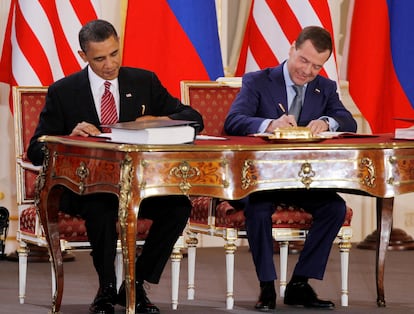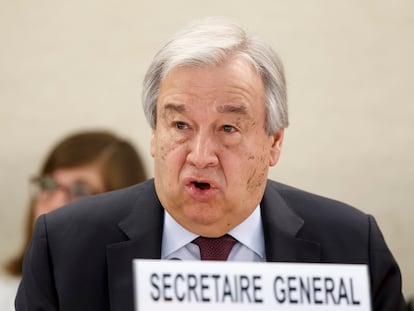The world returns to an era of nuclear angst
Russia’s suspension of its arms control treaty with the US augurs a new period of military deterrence, arms races and instability

Dmitry Medvedev is currently the deputy chairman of the Security Council of the Russian Federation (SCRF), a consultative body that supports Russian President Vladimir Putin’s decision-making on national security affairs. In April 2010, when the United States and Russia signed the New Strategic Arms Reduction Treaty (New START) in Prague, limiting the nuclear offensive capabilities of both countries, the man in charge in Moscow, at least on paper, was Medvedev, then the president of the country. In late February, Putin suspended the treaty that Obama and Medvedev signed almost 13 years ago. At the New START signing ceremony, Medvedev said, “This will turn a new page for cooperation between our two countries and will create safer conditions for life here and around the world.” Not anymore.
Medvedev is one of the best examples of how nuclear security has changed since the Cold War between the US and Russia. He now fervently supports suspending the treaty he signed in 2010 and said in a Telegram post, “If the US intends to defeat Russia [by providing military support to Ukraine], then we are on the brink of a global conflict. We have the right to defend ourselves with any weapon, including nuclear ones.”
EL PAÍS consulted four arms control and security policy experts on the consequences of Putin’s suspension of the New START treaty. They all concurred that both countries had been complying with limits on warheads, missiles and delivery systems and felt that controlling such weapons would become complicated and potentially lead to a new arms race. Moscow’s move is an attempt to curb Western support for Ukraine, and without New START, there will be more uncertainty, instability and potential nuclear miscalculations. These same words and scenarios defined the Cold War geopolitical tension that dominated US-Russian relations for 40 years after World War II.
“Without the treaty, [the US and Russia] can do whatever they want,” said Olga Oliker, an expert on Russian and Ukrainian security policy for the International Crisis Group. “They can build whatever strategic offensive weapons they feel like and can afford. They won’t be able to verify what the other is or isn’t doing. They will still have intelligence-collecting capabilities but not the inspections, data exchanges and consultations to ensure compliance. Theoretically, they could deceive each other more easily.” Oliker believes the most significant risk in suspending the treaty lies in the potential “misunderstandings” arising from a lack of information.
New START limits the number of immediately deployable nuclear weapons owned by the US and Russia, which account for 90% of the world’s nuclear arsenal. They can only have a maximum of 1,550 deployed warheads and 700 long-range missile delivery systems between ground launchers, submarines and bombers. According to the US State Department, as of September 2022, both countries were below those numbers. It was a drastic reduction compared to the 1991 treaty Ronald Reagan and Mikhail Gorbachev signed. New START also initiated a compliance mechanism that permitted up to 18 inspections a year, regular information exchange and a monitoring commission, all of which are now suspended.
Non-compliance with inspections
Todd Sechser is a professor at the University of Virginia (USA) and a scholar at the Carnegie Endowment for International Peace. “The treaty is important not only because it limits the number of strategic nuclear warheads,” said Sechser, “but because it provides a way for the two countries to build trust. This move undermines that trust.” Sechser, who coauthored Nuclear Weapons and Coercive Diplomacy (2016), says that Putin’s treaty suspension may not have any immediate impacts because there have been no inspections since March 2020 due to the COVID-19 pandemic and Moscow’s recalcitrance. “As a result, the US State Department reported [in January 2023] that it can no longer confirm Russia’s compliance with the treaty.”

Russia recently said that it has no intention of exceeding the agreed limits, although direct verification is impossible without inspections or data exchange. It is also very emphatic that “circumstances” have changed “radically,” a significant new perspective. After the Federation Council (the upper house of the Russian parliament) ratified the treaty’s suspension, Deputy Chairman Konstantin Kosachev said the decision is supported by the 1969 Vienna Convention on the Law of Treaties, which permits suspensions due to fundamental changes in the circumstances under which a treaty was signed.
In other words, Moscow believes that Washington’s support for Ukraine makes them enemies again and forces Russia to augment its defenses, including nuclear ones. In an interview with the Tass news agency, Igor Korotchenko, director of Russia’s National Defense journal, said the way is clear for boosting the Russian arsenal to match the combined capabilities of the USA, France and the United Kingdom. While the two European nuclear powers are not signatories to New START, they are committed allies of Ukraine.
New START is the most recent major nuclear arms control initiative between the US and Russia. It was a long road to get there, as ratification by the legislative bodies of both countries was needed. The treaty gave seven years to reduce deployable arsenals to the agreed levels, achieved in February 2018. But while the agreement was broadly successful and vital for maintaining nuclear stability, it also had significant failings. Washington accused Moscow of preventing inspections, while the latter challenged the American conversions of B-52H bombers and Trident II submarines into non-nuclear systems.
A new arms race
In February 2021, the Biden and Putin administrations greenlighted a five-year extension of New START, which expires in 2026. Many experts fear that there is not enough time to negotiate a new treaty to take effect after that date since it took 10 years to negotiate and sign New START. “If the treaty is annulled or if it expires in 2026 without a replacement,” said Shannon Bugos, a policy analyst at the Arms Control Association, “Washington and Moscow will lose an essential vantage point into each other’s nuclear arsenals. This will lead to instability and, in a worst-case scenario, to a new arms race.” An arms race will require more investment, which appears beyond the reach of both powers right now. But over time, pressure from the powerful arms industry lobby may weigh heavily on politicians.
Monica Montgomery of the Center for Arms Control and Non-Proliferation also believes that “the [New START] treaty enabled communication that reduced the risk of miscalculations, arms races and nuclear conflicts.” This benefit is now fading in light of Putin’s treaty suspension. “New START will expire in February 2026,” said Montgomery, “and the US and Russia have not met to work on a framework for a future treaty due to the war in Ukraine. While the US is willing to insulate arms control from the war and other geopolitical considerations, Russia has chosen not to follow suit.”
Since its invasion began, Russia has rattled its nuclear saber, especially its long-range weaponry, attempting to cow Ukrainian resistance and weaken Western support. But the deterring effects of this tactic are negligible, says Todd Sechser. “It’s remarkable how little Putin’s nuclear threats have achieved. The Ukrainians have not backed down, and the West is increasing, not decreasing, its support for the Ukrainian war effort.” In late February, Mircea Geoană, a Romanian politician and NATO’s deputy secretary general, said, “The Kremlin is basically trying to intimidate Western public opinion.”
Sign up for our weekly newsletter to get more English-language news coverage from EL PAÍS USA Edition
Tu suscripción se está usando en otro dispositivo
¿Quieres añadir otro usuario a tu suscripción?
Si continúas leyendo en este dispositivo, no se podrá leer en el otro.
FlechaTu suscripción se está usando en otro dispositivo y solo puedes acceder a EL PAÍS desde un dispositivo a la vez.
Si quieres compartir tu cuenta, cambia tu suscripción a la modalidad Premium, así podrás añadir otro usuario. Cada uno accederá con su propia cuenta de email, lo que os permitirá personalizar vuestra experiencia en EL PAÍS.
¿Tienes una suscripción de empresa? Accede aquí para contratar más cuentas.
En el caso de no saber quién está usando tu cuenta, te recomendamos cambiar tu contraseña aquí.
Si decides continuar compartiendo tu cuenta, este mensaje se mostrará en tu dispositivo y en el de la otra persona que está usando tu cuenta de forma indefinida, afectando a tu experiencia de lectura. Puedes consultar aquí los términos y condiciones de la suscripción digital.
More information
Archived In
Últimas noticias
Mexican peso defies uncertainty with forecasts of a new period of stability in 2026
Meghan Markle’s year of redemption: Numerous projects, some setbacks and a brand that is finally taking off
David King, chemist: ‘There are scientists studying how to cool the planet; nobody should stop these experiments from happening’
The end of the American dream gives way to Guatemalan opportunity
Most viewed
- Sinaloa Cartel war is taking its toll on Los Chapitos
- Oona Chaplin: ‘I told James Cameron that I was living in a treehouse and starting a permaculture project with a friend’
- Reinhard Genzel, Nobel laureate in physics: ‘One-minute videos will never give you the truth’
- Why the price of coffee has skyrocketed: from Brazilian plantations to specialty coffee houses
- Silver prices are going crazy: This is what’s fueling the rally











































